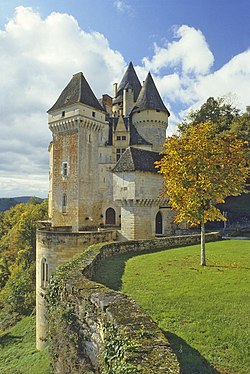Nouvelle-Aquitaine
Administrative region of France / From Wikipedia, the free encyclopedia
Dear Wikiwand AI, let's keep it short by simply answering these key questions:
Can you list the top facts and stats about Nouvelle-Aquitaine?
Summarize this article for a 10 years old
Nouvelle-Aquitaine (French pronunciation: [nuvɛl akitɛn] ⓘ; Occitan: Nòva Aquitània [ˈnɔβɔ akiˈtanjɔ] or Novèla Aquitània [nuˈβɛlɔ akiˈtanjɔ]; Basque: Akitania Berria;[2] Poitevin-Saintongeais: Novéle-Aguiéne) is the largest administrative region in France, spanning the west and southwest of the mainland. The region was created by the territorial reform of French regions in 2014 through the merger of three regions: Aquitaine, Limousin and Poitou-Charentes. It covers 84,036 km2 (32,446 sq mi) – or 1⁄8 of the country – and has 5,956,978 inhabitants (municipal population on 1 January 2017).[3] The new region was established on 1 January 2016, following the regional elections in December 2015.[4]
Nouvelle-Aquitaine
| |
|---|---|
 The Château de la Roque in Meyrals | |
 | |
| Country | |
| Prefecture | Bordeaux |
| Departments | |
| Government | |
| • President of the Regional Council | Alain Rousset (PS) |
| Area | |
| • Total | 84,036 km2 (32,446 sq mi) |
| • Rank | 1st |
| Population | |
| • Total | 6,033,952 |
| • Density | 72/km2 (190/sq mi) |
| Demonym | New-aquitanians |
| Time zone | UTC+01:00 (CET) |
| • Summer (DST) | UTC+02:00 (CEST) |
| ISO 3166 code | FR-NAQ |
| GDP () | Ranked |
| Total | €157.6 Billion ($173.8 Billion ) |
| Per capita | €26 240 ($28 960) |
| Official languages | French |
| Website | www |
It is the largest region in France by area (including overseas regions such as French Guiana), with a territory slightly larger than that of Austria. Its prefecture and largest city, Bordeaux, together with its suburbs and satellite cities, forms the seventh-largest metropolitan area of France, with 850,000 inhabitants. The region has 25 major urban areas, among which the most important after Bordeaux are Bayonne (288,000 inhabitants), Limoges (283,000), Poitiers (255,000), Pau (241,000) and La Rochelle (206,000), as well as eleven major clusters.
New Aquitaine has five universities (Bordeaux, La Rochelle, Limoges, Poitiers and Pau) and several Grandes Écoles. It has three of the four historic resorts on the French Atlantic coast: Arcachon, Biarritz and Royan, as well as several ski resorts (most notably Gourette).
Its economy is based on agriculture and viticulture (vineyards of Bordeaux and Cognac), tourism, a powerful aerospace industry, digital economy and design, parachemical and pharmaceutical industries, financial sector (Niort) and industrial ceramics (Limoges). The new region includes major parts of Southern France ("Midi de la France"), marked by Basque, Occitan, Poitevin and Saintongeais cultures. Historically, it is the "indirect successor" to medieval Aquitaine; it extends over a large part of the former Duchy of Eleanor of Aquitaine.

